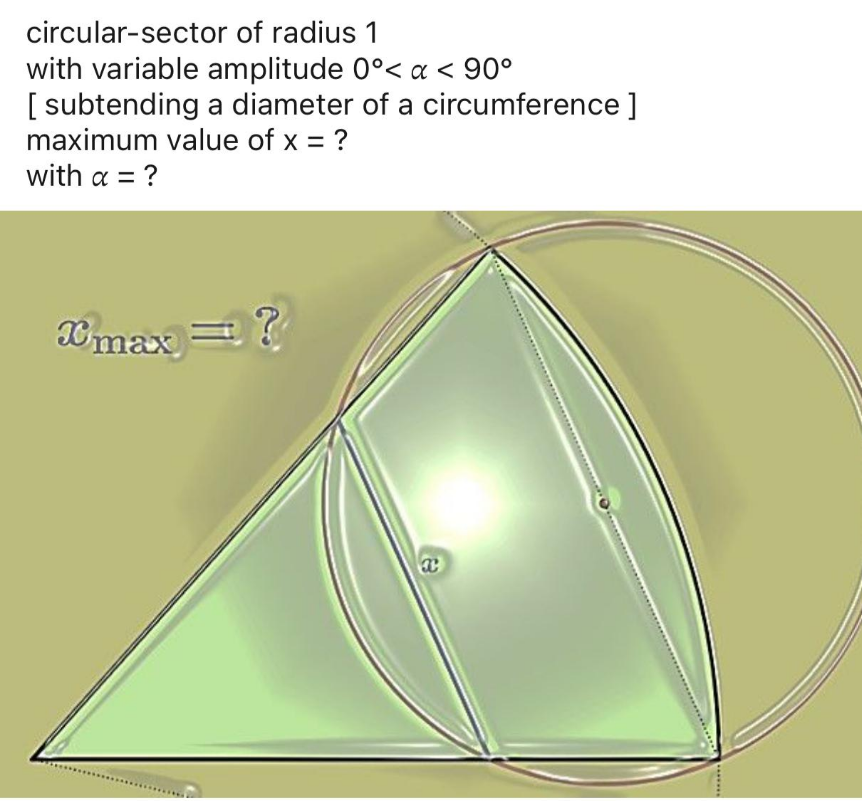
Question and Answers Forum
AllQuestion and Answers: Page 234














Pg 229 Pg 230 Pg 231 Pg 232 Pg 233 Pg 234 Pg 235 Pg 236 Pg 237 Pg 238
|
Question and Answers Forum |
AllQuestion and Answers: Page 234 |
| proof that 0^0 =1 without limit! |
| many people say that the 0^(0 ) is an uninfinity ones of them say that 0^0 is infinity and equal to 1! what do you think wich ones of them say right? |
| a_(1 ) , a_2 , a_(3 ) , .... , a_n is a sequence satifies that a_(n+2) =a_(n+1) −a_n for n ≥ 1. suppose the sum of the first 999 terms = 1003 and the sum of the first 1003 terms = −999 find the sum of the first 2002 terms. |

|

|

|
| Σ_(n=1) ^∞ Σ_(m=1) ^∞ [((m^2 n)/(3^m (3^n .m+3^m .n)))]=λ find λ. |

|

|
| This might be helpful: How to easily calculate z_1 ^z_2 with z_1 , z_2 ∈C: Transform z_1 =re^(iθ) and z_2 =a+bi ⇒ z_1 ^z_2 =(re^(iθ) )^(a+bi) z_1 ^z_2 =r^(a+bi) e^(−bθ+iaθ) z_1 ^z_2 =r^a e^(−bθ) r^(bi) e^(iaθ) z_1 ^z_2 =(r^a /e^(bθ) )e^(i(aθ+bln r)) |

|
| Let ABCD be a rectangle having an area of 290. Let E be on BC such that BE : BC = 3 : 2. Let F be on CD such that CF : FD = 3 : 1. If G is the intersection of AE and BF, compute the area of △BEG. |

|
| solve; lim_(x→0) x^2 tan(((sinπx)/(2x))) solution let L=lim_(x→0) x^2 tan(((sinπx)/(2x))) since sinx∼x−(x^3 /6) L=lim_(x→0) x^2 tan(((πx)/(2x))−((π^3 x^3 )/(12x))) L=lim_(x→0) x^2 tan((π/2)−((π^3 x^2 )/(12))) since tan((π/2)−x)=(1/(tanx)) L=lim_(x→0) (x^2 /(tan(((π^3 x^2 )/(12))))) L=lim_(x→0) (((π^3 x^2 )/(12))/(tan(((π^3 x^2 )/(12))))) ((12)/π^3 ) L=((12)/π^3 )lim_(x→0) (((π^3 x^2 )/(12))/(tan(((π^3 x^2 )/(12))))) since lim_(x→0) (x/(tanx))=1 L=((12)/π^3 ) ∙1=((12)/π^3 ) solved by HY a.k.a senestro |
| how can find the sum Σ_(i=1) ^r (2v_i +1) ? |
| lim_(x→0) x^2 tan (((sin πx)/(2x))) =? |
| If f(t) = 2(e^t − 1) a) Does f(t) exists for all n ? b) If it exist, does it converge ? c) If the sequence converge, does the limit converge ? d) Is the solution uniques ? |

|

|

|

|
| { ((tan (α+2β)=(√(1+2k)))),((tan^2 (α+β){1+k tan^2 β}=k+tan^2 β)) :} Find cot 2β . |
| R=((3sin 5°+4cos 5°−5cos 58°+35(√2) cos 13°)/(cos 5°))=? |

|

|

|
Pg 229 Pg 230 Pg 231 Pg 232 Pg 233 Pg 234 Pg 235 Pg 236 Pg 237 Pg 238 |